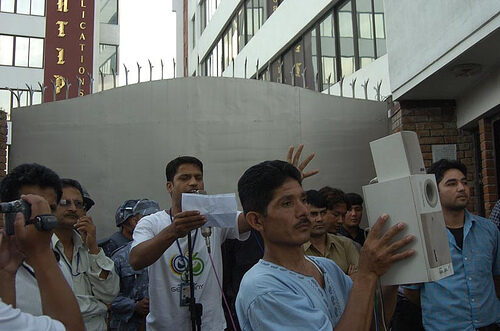Rethinking About Media Sources
Yesterday saw an event that needs to me considered by the media personnel. A group of people protested in front of Kantipur Complex, the building that houses the biggest daily Kantipur and Kantipur TV among others and curtailed it for more than four hours. Only after Kantipur TV representative read an apology and promised fair coverage, the crisis ended.
The case: Kantipur TV broadcasted news about death of a karate player wrongly. A police official shot him dead. The policeman said he was trying to loot him while the family and others were simply denying believing that version. Kantipur TV broadcasted news as they got it from police.
I am not going into who was right. I am neutral (meaning I don’t have sufficient proof to believe any story). The only thing I am considering on the case is use of sources by the media.
Traditionally, reports on crime are published as they are received from police. That is natural because they have more authentic information aided by the expert investigation. Same happens in many fields – in sports we believe what an official will say or more than that we believe players.
Theoretically, journalists should confirm any information they receive and the simplest way to do that is talk to the involved parties. If an office bearer says his officer is doing wrong, then we talk to his officer.
Police are neutral party and expert (that is UNLESS they are involved in the incident). In this case, the simple mistake done was that the journalists failed to understand that the police was one party involved in the case and in that case there may be biasness. As a journalist, it would have been great for everybody if the report was balanced (by using at least a quote from the second party – in this case the family of deceased).
That wasn’t done and that created the problem.

Kantipur Representative apologies. Photo via MeroSansar
Let Free Media Grow
Wrong! Wrong!! I have no other word to say about the incident. How fair it was to block a media house and restricting movement of the journalists in and out from the media house. Its not for the first time that Kantipur was targeted (it was vandalized during the Royal Regime) and this time too the chief reporter of Kantipur claims at least two of the people involved were royalists.
Kantipur is the biggest media house (being biggest isn’t easy). As a journalist working in other daily before I moved to The Kathmandu Post, I always got angry when the organizer would wait for a Kantipur reporter. That has probably gone down these days but there are still a lot of people who dislike Kantipur. For the leading role it played against Royal Regime, royalists are angrier than anybody else and they would look for any opportunity for planning out something against it.
For other, (who may be being used for wrong cause), let media be free and there are ways to get something out of media. Even talking to the media boss sometimes is good idea; if not then a delegation. Free media always looks for fair reports (they won’t tolerate anything against their freedom) but for other things they will go for truth.
Free media is power for freedom and democracy (already proved) so let free media grow.
0 responses to “Two Thoughts on Nepali Journalism”
????
?????????????????????
?????GODIVA ???????????? – STYLE-TIPS.COM ??????????????????????????????GODIVA ???…
???????????????????????????????????????????
Manchester United legend Sir Alex Ferguson has claimed he knew Michael Carrick was going to be a massive success at the club before he had even agreed a deal to sign him from Tottenham. Manchester United legend Sir Alex Ferguson explains how he knew Michael Carrick was certain to be a ‘big success’ before he signed him